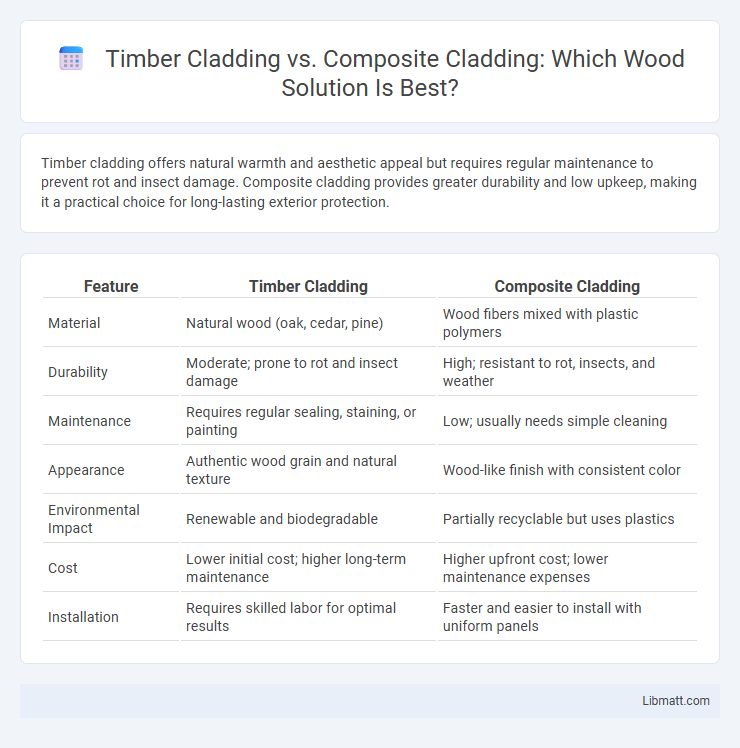Timber cladding offers natural warmth and aesthetic appeal but requires regular maintenance to prevent rot and insect damage. Composite cladding provides greater durability and low upkeep, making it a practical choice for long-lasting exterior protection.
Table of Comparison
| Feature | Timber Cladding | Composite Cladding |
|---|---|---|
| Material | Natural wood (oak, cedar, pine) | Wood fibers mixed with plastic polymers |
| Durability | Moderate; prone to rot and insect damage | High; resistant to rot, insects, and weather |
| Maintenance | Requires regular sealing, staining, or painting | Low; usually needs simple cleaning |
| Appearance | Authentic wood grain and natural texture | Wood-like finish with consistent color |
| Environmental Impact | Renewable and biodegradable | Partially recyclable but uses plastics |
| Cost | Lower initial cost; higher long-term maintenance | Higher upfront cost; lower maintenance expenses |
| Installation | Requires skilled labor for optimal results | Faster and easier to install with uniform panels |
Introduction to Timber and Composite Cladding
Timber cladding offers natural beauty, durability, and excellent insulating properties derived from sustainably sourced wood, making it a popular choice for eco-friendly and traditional architectural designs. Composite cladding combines wood fibers with plastic polymers, providing enhanced resistance to weather, decay, and pests while requiring less maintenance than timber. Understanding the unique benefits and applications of both materials will help you select the best cladding solution for your building's aesthetic and functional needs.
Key Material Differences
Timber cladding consists of natural wood, offering unique grain patterns, breathability, and thermal insulation, but requires regular maintenance to prevent rot and insect damage. Composite cladding combines wood fibers with plastic resins, providing enhanced durability, low maintenance, and resistance to moisture, UV rays, and pests. Timber tends to be more environmentally sustainable if sourced responsibly, while composite materials offer consistent quality and longer life spans in harsh climates.
Aesthetic Appeal and Design Flexibility
Timber cladding offers a natural, warm aesthetic with unique grain patterns that enhance architectural character and allows for versatile treatment options such as staining, painting, and carving to customize appearance. Composite cladding provides consistent color and texture with a modern, uniform look, featuring design flexibility through a wide range of finishes, profiles, and sizes that mimic wood or stone without compromising durability. Both materials support creative architectural expression, but timber excels in authenticity while composite excels in maintenance-free versatility.
Durability and Weather Resistance
Timber cladding offers natural insulation but requires regular maintenance to prevent rot, warping, and insect damage, especially in harsh weather conditions. Composite cladding boasts superior durability and weather resistance due to its synthetic materials, resisting moisture, UV rays, and temperature fluctuations without needing frequent upkeep. Choosing composite cladding enhances Your home's longevity and protection against severe weather, making it a low-maintenance alternative to traditional timber.
Environmental Impact and Sustainability
Timber cladding, sourced from sustainably managed forests, offers excellent carbon sequestration and is biodegradable, making it a highly eco-friendly option compared to composite cladding, which often contains non-recyclable plastics and synthetic resins. Composite cladding generally requires less maintenance and has a longer lifespan, reducing resource consumption over time, but its production and disposal can contribute to environmental pollution. Your choice between timber and composite cladding should consider the balance between renewable resource use and the long-term durability to optimize sustainability.
Installation Process and Maintenance
Timber cladding requires precise cutting, nailing, and treatments to prevent rot and insect damage, demanding regular sanding and sealing for maintenance, while composite cladding involves interlocking panels or boards with hidden fasteners, ensuring a quicker, cleaner installation and minimal upkeep due to its resistance to fading, moisture, and pests. Timber's natural expansion and contraction necessitate periodic inspections and touch-ups to maintain appearance and structural integrity. Composite cladding offers superior durability with less frequent maintenance, primarily involving simple cleaning to remove dirt and debris.
Cost Comparison
Timber cladding typically has a lower upfront cost, with prices ranging from $15 to $30 per square foot, while composite cladding can cost between $25 and $45 per square foot, reflecting its durability and low maintenance benefits. Over time, composite cladding often proves more cost-effective due to reduced upkeep, as timber requires regular treatment and potential repairs. Your choice depends on balancing initial investment with long-term maintenance expenses.
Fire Resistance and Safety Considerations
Timber cladding offers a natural aesthetic but generally has lower fire resistance compared to composite cladding, which often incorporates fire-retardant materials and certifications like BR135. Composite cladding provides enhanced safety in fire-prone areas due to its non-combustible properties and compliance with building regulations. When prioritizing fire resistance, your choice should align with local fire safety standards and the specific risk profile of your building site.
Popular Applications and Use Cases
Timber cladding is widely used in residential homes and heritage buildings for its natural aesthetic, excellent insulation properties, and eco-friendly appeal. Composite cladding, made from a mix of wood fibers and plastic, suits modern commercial buildings and high-moisture environments due to its durability, low maintenance, and resistance to rot and insect damage. Your choice depends on whether you prioritize traditional warmth and sustainability or long-lasting performance and weather resistance.
Choosing the Right Cladding for Your Project
Timber cladding offers natural aesthetics, sustainability, and excellent insulation, making it ideal for projects emphasizing environmental benefits and traditional design. Composite cladding provides durability, low maintenance, and resistance to rot and insects, suitable for long-lasting performance in harsh weather conditions. Your choice depends on prioritizing either natural appeal with periodic upkeep or enhanced longevity with minimal maintenance.
Timber cladding vs composite cladding Infographic

 libmatt.com
libmatt.com